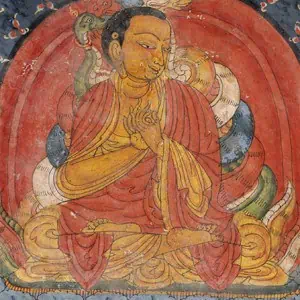Quiz questions Part 8 for Precious Garland

- What are the three general causes for becoming a bodhisattva? How can bodhicitta be a cause of bodhisattvas when someone enters the bodhisattva path at the same time as they generate uncontrived bodhicitta?
- What is the nondual wisdom? What duality is it free from? What are other meanings of nonduality?
- What are the characteristics of a modest faculty bodhisattva and a sharp faculty bodhisattva? What things can you do to try to become a sharp faculty bodhisattva?
- Are there some of the 32 signs of a Buddha that specifically spark your interest? Are there some of the causes of these signs that make you reflect on your attitude and behavior?
- Why is the merit necessary to attain buddhahood immeasurable? What enables us to create such immeasurable merit? Why?
- What is Buddha? What is an arya Buddha? What characteristics are both, neither, and one but not the other?
- Do hearers practice the collection of merit and the collection of wisdom? How do hearers’ creation of merit differ from bodhisattvas’ creation of merit?
- What factors are necessary for our creation of merit to become the collection of merit?
- What are the 2 Buddha bodies? 3 Buddha bodies? 4 Buddha bodies? 5 Buddha bodies? Which ones are permanent and impermanent?
- What are the various parts of a syllogism? What are the three criteria necessary to realize the thesis of a correct syllogism? Is the mind that realizes a syllogism conceptual or nonconceptual?
- What are the practices of method and wisdom? What does it mean to practice method and wisdom in an integrated manner? How do method and wisdom relate to the two collections? The two Buddha bodies? The two truths?
- Why is discouragement a wrong consciousness? What incorrect statements do you tell yourself that make you discouraged?
- Describe the antidotes to discouragement that Nagarjuna gives. What are the four immeasurable factors?
- How do the two collections counteract physical and mental suffering?
Venerable Thubten Chodron
Venerable Chodron emphasizes the practical application of Buddha’s teachings in our daily lives and is especially skilled at explaining them in ways easily understood and practiced by Westerners. She is well known for her warm, humorous, and lucid teachings. She was ordained as a Buddhist nun in 1977 by Kyabje Ling Rinpoche in Dharamsala, India, and in 1986 she received bhikshuni (full) ordination in Taiwan. Read her full bio.
